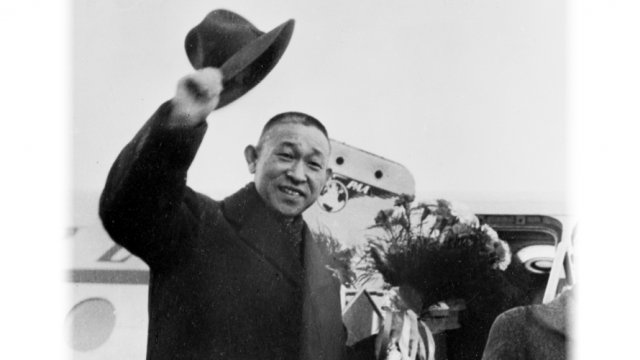
Dec 25, 2025
- Products & Solutions
- Stories
- Technology
- AI & Robotics
- R&D
- Business Solutions

Sixty-five years ago, on January 18, 1951, a Pan American airplane took off from Haneda Airport with one passenger being Konosuke Matsushita making his first overseas visit. His destination was the United States. Upon breaking free from the postwar predicament, he immediately turned his eyes to the world.
Photo: Konosuke Matsushita climbing aboard an airplane at Haneda Airport
"In the midst of the storm, Matsushita Electric has finally risen to its feet." Konosuke Matsushita made this statement at the Extraordinary Management Policy Meeting on July 17, 1950. A half year later, on January 6, 1951 at the Annual Management Policy Meeting for fiscal 1951 he began by saying, "After passing through postwar difficulties, we are now expanding our vision to the world. Previously, we would make decisions from the standpoint of being Japanese, but now we must put ourselves in the position of being a global citizen." Konosuke continued:
"Up until now, we've managed to do business with a narrow outlook. But, today, as a global corporate citizen we must conduct business activities worldwide while utilizing the good things about Japan. With a consciousness of being a member of the human race throughout the world, we must re-examine and renovate our company's management. To devote ourselves to this initiative and promptly achieve results, we should approach management with the attitude that 'Matsushita Electric has just begun a business again today.'"
After giving this speech, he announced, "I will visit the United States immediately." The purpose of his visit was to see with his own eyes what kinds of products could be exported overseas, whether it was necessary to introduce overseas technologies, and what his company should learn from overseas businesses regarding corporate management.
After the Management Policy Meeting, a send-off party was held at the Head Office. In an air of excitement, Konosuke expressed his strong aspirations by saying, "In this year which we started by making a mutual commitment to each other to launch into the global market, it is extremely important to establish a rational policy for prosperity. On this point, I will depart in the hope of bringing back a plentiful harvest."
Four days later, on January 10, with an enthusiastic send-off at Osaka Station, Konosuke headed to Tokyo. On the afternoon of January 18, the day of departure, another send-off party was held at the Tokyo branch office where a former Japanese ambassador to the United States, Kichisaburo Nomura* who was an elder friend of Konosuke from the same Wakayama prefecture, offered words of encouragement. Amidst loud acclamations, he left the branch office for Haneda Airport and at six o'clock in the evening walked up the stairs to board a Pan Am Clipper.

In New York, in January 1951
Konosuke's route took him to Wake Island and Honolulu before arriving on the mainland. During his visit until he returned home on April 7, which was extended from an original plan of staying a month, he wrote down and sent his impressions to Japan from everywhere he went, which were posted in the in-house newsletter under the heading of "Reports from America." In addition to business-related contents, his viewpoints were diverse, such as "Strongly impressed by people's sense of public morality," "Women are active in society everywhere," and "Young employees must learn English."
Through his three-month trip to the United States, he realized a huge gap between Japan and the United States, in terms of the prosperity of society. The difference in the levels of electronics technology was also obvious. His assumption that "There will be many things we should learn from advanced companies overseas" turned into a conviction. This led to a technical tie-up with Philips in the following year, 1952.
*Konosuke later selected Nomura to be the president of Victor Company of Japan.
The content in this website is accurate at the time of publication but may be subject to change without notice.
Please note therefore that these documents may not always contain the most up-to-date information.
Please note that German, Spanish and Chinese versions are machine translations, so the quality and accuracy may vary.